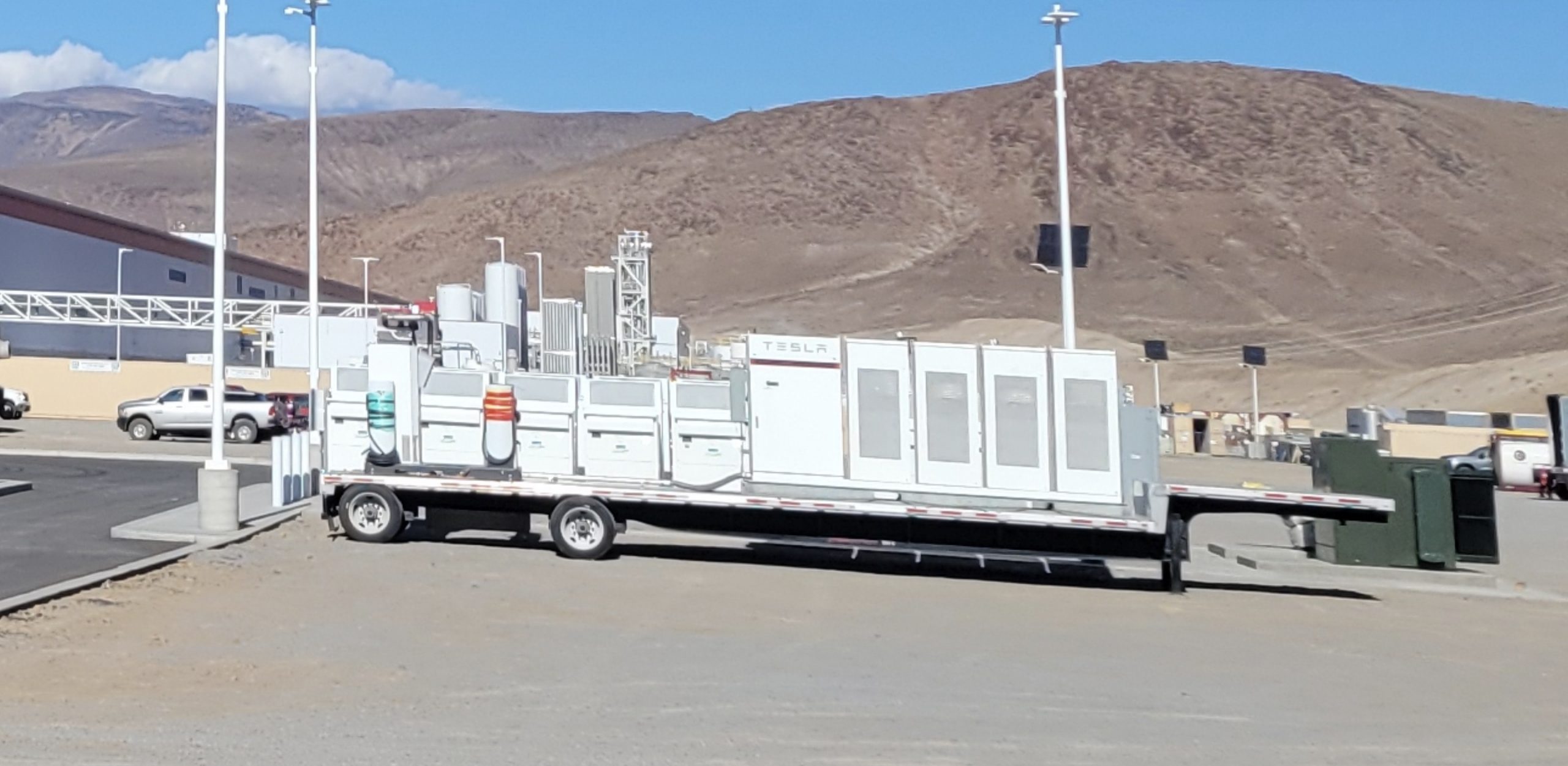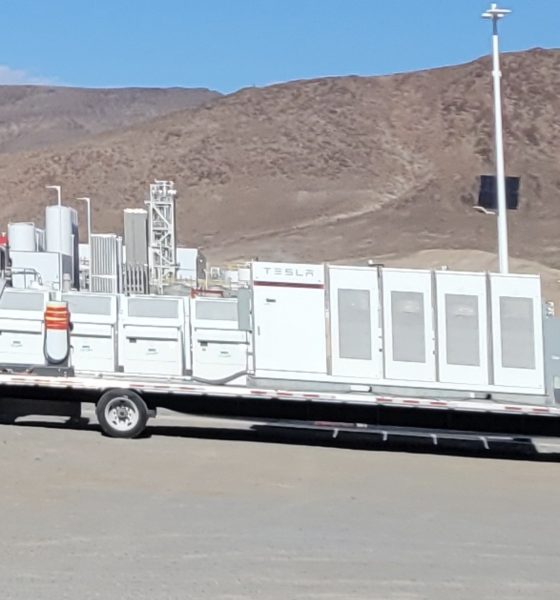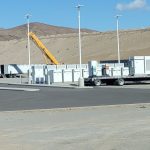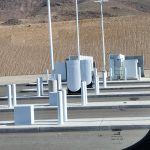

News
Tesla Giga Nevada images hint at potential mobile “Megacharger” solution
New images from Giga Nevada suggest that Tesla may be looking to develop a mobile “Megacharger” system for the upcoming Class 8 all-electric Semi. The system seems to be powered by Powerpack batteries.
To clarify, the “Megacharger” is the name of the Semi’s charging infrastructure, as mentioned by CEO Elon Musk during the vehicle’s unveiling in late 2017. Pictures shared with Teslarati show Tesla’s progress with the buildout of Megachargers at Giga Nevada–and maybe a little more. There are a least two Megachargers at the Gigafactory, and Tesla might install more in the future, especially as the Semi’s limited production starts rolling.
However, right behind the Megachargers is a trailer with four Tesla Powerpacks and two urban charger stalls. According to Teslarati’s source, there were two trailers at Giga Nevada, and one of the trailers was fitted with Tesla Powerpacks, which may hint at a potential portable charging system.
- (Credit: Jason Colepaugh)
- (Credit: Jason Colepaugh)
Tesla’s Mobile Charger Solutions
Tesla has deployed mobile EV charging systems in the past. In 2019, Tesla deployed mobile Superchargers powered by Megapacks for the holidays. It was a simple and practical solution to increase the number of charger stalls at select Supercharger stations quickly and efficiently. Reports then indicated that the Megapack-powered mobile Superchargers could charge about 60-100 vehicles thanks to the Megapack’s 3 MWh capacity.
Mobile “Megachargers” would be a practical move for Tesla and the Semi’s clients. Mobile “Megachargers” could help top-up Semis in popular transport routes while Tesla concentrates on growing its Supercharger Network and the Semi’s dedicated charging infrastructure. Mobile “Megachargers” could also be a cost-effective way for Tesla and the Semi’s clients to ensure that chargers are present for the Class 8 electric truck in locations where they are needed the most.
Tesla deploys Megapack-powered Mobile Superchargers for the holidays
The Semi’s “Megacharger” Evolution
In 2018, a Tesla Semi prototype sighted in Des Moines, IA was spotted using an ad hoc “Megacharger” system that utilized 5 Supercharger V2 stalls. By 2020, sightings of the electric Class-8 revealed an updated ad hoc “Megacharger” solution that used only 2 Supercharger stalls. It was unknown whether the two stalls charging the Semi in 2020 were V2 or V3 Superchargers.
The trailer in the picture recently shared with Teslarati held two urban chargers, suggesting a potentially similar charging setup as the Semi prototype spotted in 2020. As for the use of Powerpacks instead of larger Megapacks, it might be down to cost.
Tesla Semi’s updated ad-hoc Megacharger setup hints at vastly improved battery unit
According to Elon Musk during a 2021 interview with noted podcast host Joe Rogan, the Semi’s 300-mile variant should be equipped with a battery pack that’s around 500 kWh. Previous estimates suggested that the Semi will be fitted with a 600 kWh battery pack for the 300-mile version and a 1 MWh battery pack for the 500-mile Semi variant.
One Megapack has a capacity of 3 MWh and costs about $1.2 million as of July 2021, when Tesla updated the Megapack’s order page. A single Megapack could potentially charge several Semis consecutively, but the costs for such a solution would be substantial. Considering that one Tesla Powerpack has a capacity of up to 232 kWh, four units of the commercial-grade battery would likely have about ~900 kWh of energy capacity. This would likely be enough to top up a couple of Semis at a time, without requiring the full costs of a Megapack-powered system.
The Teslarati team would appreciate hearing from you. If you have any tips, reach out to me at maria@teslarati.com or via Twitter @Writer_01001101.

Elon Musk
Starlink passes 9 million active customers just weeks after hitting 8 million
The milestone highlights the accelerating growth of Starlink, which has now been adding over 20,000 new users per day.

SpaceX’s Starlink satellite internet service has continued its rapid global expansion, surpassing 9 million active customers just weeks after crossing the 8 million mark.
The milestone highlights the accelerating growth of Starlink, which has now been adding over 20,000 new users per day.
9 million customers
In a post on X, SpaceX stated that Starlink now serves over 9 million active users across 155 countries, territories, and markets. The company reached 8 million customers in early November, meaning it added roughly 1 million subscribers in under seven weeks, or about 21,275 new users on average per day.
“Starlink is connecting more than 9M active customers with high-speed internet across 155 countries, territories, and many other markets,” Starlink wrote in a post on its official X account. SpaceX President Gwynne Shotwell also celebrated the milestone on X. “A huge thank you to all of our customers and congrats to the Starlink team for such an incredible product,” she wrote.
That growth rate reflects both rising demand for broadband in underserved regions and Starlink’s expanding satellite constellation, which now includes more than 9,000 low-Earth-orbit satellites designed to deliver high-speed, low-latency internet worldwide.
Starlink’s momentum
Starlink’s momentum has been building up. SpaceX reported 4.6 million Starlink customers in December 2024, followed by 7 million by August 2025, and 8 million customers in November. Independent data also suggests Starlink usage is rising sharply, with Cloudflare reporting that global web traffic from Starlink users more than doubled in 2025, as noted in an Insider report.
Starlink’s momentum is increasingly tied to SpaceX’s broader financial outlook. Elon Musk has said the satellite network is “by far” the company’s largest revenue driver, and reports suggest SpaceX may be positioning itself for an initial public offering as soon as next year, with valuations estimated as high as $1.5 trillion. Musk has also suggested in the past that Starlink could have its own IPO in the future.
News
NVIDIA Director of Robotics: Tesla FSD v14 is the first AI to pass the “Physical Turing Test”
After testing FSD v14, Fan stated that his experience with FSD felt magical at first, but it soon started to feel like a routine.

NVIDIA Director of Robotics Jim Fan has praised Tesla’s Full Self-Driving (Supervised) v14 as the first AI to pass what he described as a “Physical Turing Test.”
After testing FSD v14, Fan stated that his experience with FSD felt magical at first, but it soon started to feel like a routine. And just like smartphones today, removing it now would “actively hurt.”
Jim Fan’s hands-on FSD v14 impressions
Fan, a leading researcher in embodied AI who is currently solving Physical AI at NVIDIA and spearheading the company’s Project GR00T initiative, noted that he actually was late to the Tesla game. He was, however, one of the first to try out FSD v14.
“I was very late to own a Tesla but among the earliest to try out FSD v14. It’s perhaps the first time I experience an AI that passes the Physical Turing Test: after a long day at work, you press a button, lay back, and couldn’t tell if a neural net or a human drove you home,” Fan wrote in a post on X.
Fan added: “Despite knowing exactly how robot learning works, I still find it magical watching the steering wheel turn by itself. First it feels surreal, next it becomes routine. Then, like the smartphone, taking it away actively hurts. This is how humanity gets rewired and glued to god-like technologies.”
The Physical Turing Test
The original Turing Test was conceived by Alan Turing in 1950, and it was aimed at determining if a machine could exhibit behavior that is equivalent to or indistinguishable from a human. By focusing on text-based conversations, the original Turing Test set a high bar for natural language processing and machine learning.
This test has been passed by today’s large language models. However, the capability to converse in a humanlike manner is a completely different challenge from performing real-world problem-solving or physical interactions. Thus, Fan introduced the Physical Turing Test, which challenges AI systems to demonstrate intelligence through physical actions.
Based on Fan’s comments, Tesla has demonstrated these intelligent physical actions with FSD v14. Elon Musk agreed with the NVIDIA executive, stating in a post on X that with FSD v14, “you can sense the sentience maturing.” Musk also praised Tesla AI, calling it the best “real-world AI” today.
News
Tesla AI team burns the Christmas midnight oil by releasing FSD v14.2.2.1
The update was released just a day after FSD v14.2.2 started rolling out to customers.

Tesla is burning the midnight oil this Christmas, with the Tesla AI team quietly rolling out Full Self-Driving (Supervised) v14.2.2.1 just a day after FSD v14.2.2 started rolling out to customers.
Tesla owner shares insights on FSD v14.2.2.1
Longtime Tesla owner and FSD tester @BLKMDL3 shared some insights following several drives with FSD v14.2.2.1 in rainy Los Angeles conditions with standing water and faded lane lines. He reported zero steering hesitation or stutter, confident lane changes, and maneuvers executed with precision that evoked the performance of Tesla’s driverless Robotaxis in Austin.
Parking performance impressed, with most spots nailed perfectly, including tight, sharp turns, in single attempts without shaky steering. One minor offset happened only due to another vehicle that was parked over the line, which FSD accommodated by a few extra inches. In rain that typically erases road markings, FSD visualized lanes and turn lines better than humans, positioning itself flawlessly when entering new streets as well.
“Took it up a dark, wet, and twisty canyon road up and down the hill tonight and it went very well as to be expected. Stayed centered in the lane, kept speed well and gives a confidence inspiring steering feel where it handles these curvy roads better than the majority of human drivers,” the Tesla owner wrote in a post on X.
Tesla’s FSD v14.2.2 update
Just a day before FSD v14.2.2.1’s release, Tesla rolled out FSD v14.2.2, which was focused on smoother real-world performance, better obstacle awareness, and precise end-of-trip routing. According to the update’s release notes, FSD v14.2.2 upgrades the vision encoder neural network with higher resolution features, enhancing detection of emergency vehicles, road obstacles, and human gestures.
New Arrival Options also allowed users to select preferred drop-off styles, such as Parking Lot, Street, Driveway, Parking Garage, or Curbside, with the navigation pin automatically adjusting to the ideal spot. Other refinements include pulling over for emergency vehicles, real-time vision-based detours for blocked roads, improved gate and debris handling, and Speed Profiles for customized driving styles.










